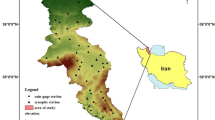Abstract
An understanding of rainfall characteristics at multiple spatiotemporal scales is of great importance for hydrological, biogeochemical, and land surface modeling studies. The paper deals with the identification of rainfall spatial patterns and its relationship with local factors (altitude, longitude, and latitude) and rainfall of Iran. The employed data consists of rainfall values measured by the rainfall gauge network, spread over the country. The statistical test performed on the collected data included spatial auto-correlation, global Moran’s index, local Moran’s index, and hotspots. The results showed that the precipitation variation in Iran followed a clustering pattern with high concentration. Univariate Local Moran statistics of 0.92 indicates that strong spatial dependence in annual rainfall in Iran. Hotspot analysis revealed hot spots pattern in north, northwest and west and also cold spots in some parts of the center, east and south-east of Iran. Moreover we found a strong significant relationship between longitude, latitude and annual rainfall of Iran (−0.54 and 0.38 respectively) but the relation between altitude and annual rainfall is about 0.016.







Similar content being viewed by others
References
Goovaerts, P. (2000). Geostatistical approaches for incorporating elevation into the spatial interpolation of rainfall. Journal of Hydrology, 228(1), 113–129.
Yatagai, A., Kamiguchi, K., Arakawa, O., Hamada, A., Yasutomi, N., & Kitoh, A. (2012). APHRODITE: Constructing a long-term daily gridded precipitation dataset for Asia based on a dense network of rain gauges. Bulletin of the American Meteorological Society, 93(9), 1401–1415.
Jacquez, G. M. (2008). Spatial cluster analysis. In S. Fotheringham & J. Wilson (Eds.), The handbook of geographic information science (pp. 395–416). Oxford: Blackwell Publishing.
Gustatson, E. J. (1998). Quantifying landscape spatial patterns: What is the state of the art? Journal of Ecosystems, 1(2), 143–156.
Alijani, B. (2008). Effect of the Zagros Mountains on the spatial distribution of precipitation. Journal of Mountain Science, 5(3), 218–231.
Raziei, T., Daryabari, J., Bordi, I., & Pereira, L. S. (2014). Spatial patterns and temporal trends of precipitation in Iran. Theoretical and Applied Climatology, 115(3), 531–540.
Sabziparvar, A., Movahedi, S., Asakereh, H., Maryanaji, Z., & Masoodian, S. A. (2015). Geographical factors affecting variability of precipitation regime in Iran. Theoretical and Applied Climatology, 120(1–2), 367–376.
Ghassabi, Z., Kamali, G. A., Meshkatee, A.-H., Hajam, S., & Javaheri, N. (2016). Time distribution of heavy rainfall events in south west of Iran. Journal of Atmospheric and Solar-Terrestrial Physics, 145, 53–60.
Khalili, K., Tahoudi, M. N., Mirabbasi, R., & Ahmadi, F. (2016). Investigation of spatial and temporal variability of precipitation in Iran over the last half century. Stochastic Environmental Research and Risk Assessment, 30(4), 1205–1221.
Fallah Ghalhari, G. A., Dadashi Roudbari, A. A., & Asadi, M. (2016). Identifying the spatial and temporal distribution characteristics of precipitation in Iran. Arabian Journal of Geosciences, 9(12), 595.
Darand, M., Amanollahi, J., & Zandkarimi, S. (2017). Evaluation of the performance of TRMM Multi-satellite Precipitation Analysis (TMPA) estimation over Iran. Atmospheric Research, 190, 121–127.
Razmi, R., Balyani, S., & Mansouri Daneshvar, M. R. (2017). Geo-statistical modeling of mean annual rainfall over the Iran using ECMWF database. Spatial Information Research, 25(2), 219–227.
Cliff, A. D., & Ord, J. K. (1981). Spatial processes: Models and applications (Vol. 13(1), pp. 59–60). London: Pion.
De Valck, J., Broekx, S., Liekens, I., De Nocker, L., Van Orshoven, J., & Vranken, L. (2016). Contrasting collective preferences for outdoor recreation and substitutability of nature areas using hot spot mapping. Landscape and Urban Planning, 151, 64–78.
Alijani (1995). The role of Alborze mountain in altitude distribution of rainfall. Geographical research, 38(1), 27–39.
Moradi, M. (2002). The roll of caspiean sea in rainfall distribution of north of Iran. Marine science Journal, 21(2–3), 19–31.
Asakereh, H., SeifiPour, Z. (2013). Spatial modeling of annual precipitation of Iran. Geography and development, 29, 15–30.
Asakereh, H., SeifiPour, Z. (2010). Investigation of dry days occurrence probability in golestan province using Markove Chain Model. Geography and development, 8(17), 29–44.
Anselin, L. (1988). Spatial econometrics: Methods and models. Dordrecht; Boston: Kluwer Academic Publishers.
Asakreh, H., & Razmi, R. (2012). Analysis of variations in annual precipitation in the north west of Iran. Geography and Environmental Planning, 23(3), 147–162.
Diodato, N., Tartari, G., & Bellocchi, G. (2010). Geospatial rainfall modelling at Eastern Nepalese Highland from ground environmental data. Water Resources Management, 24(11), 2703–2720.
Syed, M., & Al Amin, M. (2016). Geospatial modeling for investigating spatial pattern and change trend of temperature and rainfall. Climate, 4(2), 21.
Author information
Authors and Affiliations
Corresponding author
Rights and permissions
About this article
Cite this article
Balyani, S., Rointan, S., Qelichi, M.M. et al. Evaluating spatial structure of annual rainfall in relation to local factors in Iran. Spat. Inf. Res. 25, 411–420 (2017). https://doi.org/10.1007/s41324-017-0106-6
Received:
Revised:
Accepted:
Published:
Issue Date:
DOI: https://doi.org/10.1007/s41324-017-0106-6




